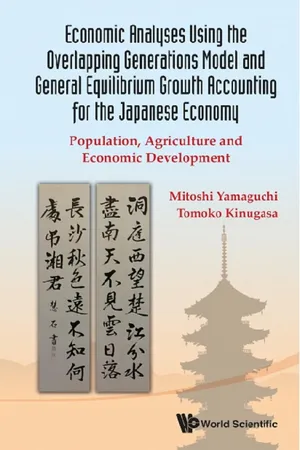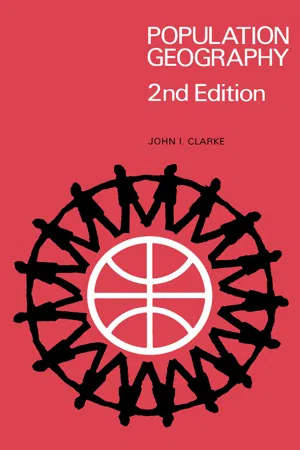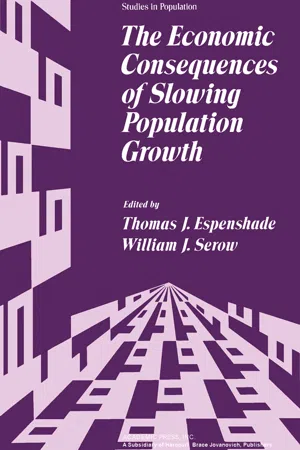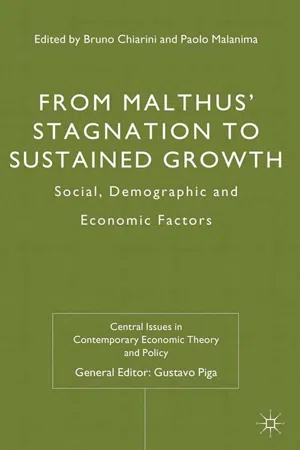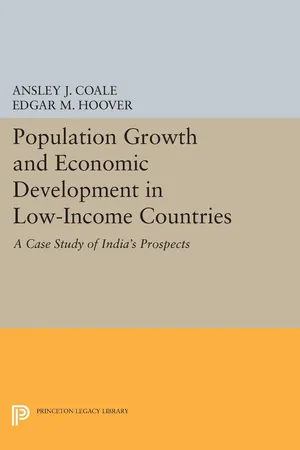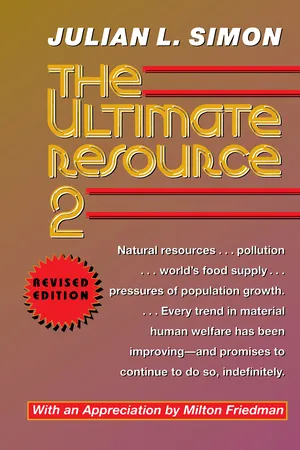Economics
Population Growth
Population growth refers to the increase in the number of individuals in a particular population over a specific period of time. In economics, population growth is a key factor influencing the supply of labor, consumer demand, and overall economic productivity. It can have significant implications for resource allocation, infrastructure development, and social welfare programs.
Written by Perlego with AI-assistance
Related key terms
1 of 5
11 Key excerpts on "Population Growth"
- Available until 4 Dec |Learn more
Economic Growth
International Edition
- David Weil(Author)
- 2016(Publication Date)
- Routledge(Publisher)
CHAPTER 4 POPULATION AND ECONOMIC GROWTH With every mouth God sends a pair of hands. —An old saying T his adage provides a good starting point for thinking about the impact of population on economic growth. It makes the point that changes in population affect both the consumption needs of an economy (the number of mouths) and the productive capacity of the economy (the number of hands). If the only thing used to produce output was labor, then the interaction of population and economic growth would not be very interesting: Twice as many people would mean twice as much output, so the size of the population would not affect output per capita. If, however, there are inputs to production other than labor, then adding one person adds one mouth and one pair of hands but no more of the other factors. In per-capita terms, more people will result in less of everything else. This simple observation is the basis for including population in models that attempt to explain income per capita. As we will see, population can be a determinant of income in two different ways. In some contexts the size of the population is important, whereas in others the growth rate is important. Specifically, when we think about the interaction of population with some fixed natural resource, the important aspect is the size of the population. Holding other factors constant, a country with a lot of people relative to the amount of resources will be poorer. But when we think about the interaction of population with a producible input such as capital, then the relevant aspect is the growth rate of population. Of course, over time, the speed with which a population grows is what determines how many people there are. But the words over time make a big difference. Countries can have slow Population Growth and a large population relative to their resources. Or they can have rapid Population Growth but a population that is small relative to their resources. Japan and Chad present examples of these two cases - eBook - PDF
- Adam Szirmai(Author)
- 2015(Publication Date)
- Cambridge University Press(Publisher)
2. The growth of population, on the other hand, also gives rise to employment challenges . Can economic development provide a rapidly growing labour force with suf fi cient productive and paid employment, or does open or disguised unemployment increase? 3. A rapidly growing population can stimulate the growth of production by providing an expanding market for goods and services. 4. The level of consumption in a society depends in part on the relationship between Population Growth and growth of production. Is the growth of production of goods and services suf fi cient to provide a growing population with an acceptable standard of living? 5. A growing population creates opportunities for productive investment and can stimulate savings . 6. The size and growth of the labour force is one of the determinants of the need for savings and investment . If investment lags behind the growth of the labour force, then – with given technology – labour productivity will tend to decline and the growth of production will not be able to keep up with the growth of population. 7. In the absence of technological change, growth of population increases the pressure on the national environment , especially when combined with increased output per capita. 8. Growth of population and increasing pressure on scarce resources can stimulate technological change. . ...................................................................................................................................................................... . 161 Population and development 5.2 Perspectives on Population Growth ................................................................................. In post-war debates on the population problem Malthusian views predominated up to the 1970s. It was thought that rapid growth of population in developing countries threatened their chances of economic development. - eBook - ePub
Economic Analyses Using The Overlapping Generations Model And General Equilibrium Growth Accounting For The Japanese Economy: Population, Agriculture And Economic Development
Population, Agriculture and Economic Development
- Mitoshi Yamaguchi, Tomoko Kinugasa(Authors)
- 2014(Publication Date)
- WSPC(Publisher)
Therefore, it would not be wise to conclude that there is no relationship between population and economic growth just by observing the correlation which appears in a figure. A more positive way would be to make a factor analysis and to consider both positive and negative effects of Population Growth. Fortunately, we can see many articles recently which observe the interrelationship between population and economic growth. However the causality of interrelationships is not simple as P. Mombelt who states that population and economic growth have a loose and not tight relationship. In this way, a problem of population and economic growth is very complicated in character and we cannot consider a too simple causality for them. However, it is our duty to make a further research and solve these complicated causalities. We economists have to use more energies for studying these problems, as Hazledine and Moreland [1977] state. In this chapter, we first consider the effects of Population Growth on the economy. Second, we consider the effects of the economy on population. Third, we consider the interrelationships between population and economy.1. Effect of Population Growth on Economy
In order to observe the effect of Population Growth on the economy, Coale and Hoover [1958] considered the items of population, the growth rate of population and age distribution. Yasuba [1969] also made the same kind of analysis. However, a better way would be to see how Population Growth was brought about to see the factors which contributed to Population Growth. For Population Growth, we have the following equation:where P denotes population, B birth, D death, IM and OM immigration and emigration. Therefore, it would be enough to see the effect of the right-hand side items in Eq. (6.1) in order to see the Population Growth’s effect on the economy. P (t - eBook - PDF
Population Geography
Pergamon Oxford Geographies
- John I. Clarke, W. B. Fisher(Authors)
- 2013(Publication Date)
- Pergamon(Publisher)
C H A P T E R Χ POPULATION G R O W T H THE reason for calling this chapter Population Growth rather than Population Change is that at national level very few populations are declining. Most are growing so rapidly that world Population Growth is one of the major problems of the present. On the other hand, within developed countries there are usually many districts experiencing population decUne. Measures of Population Growth and Replacement Apart from the absolute increase or decrease per annum, one of the most common measures of growth is the annual rate of increase. The U.N. Demo-graphic Yearbooks use the foUowing formula: X 100 where PQ is the population at the beginning of the period. Pi is the population at the end of the period, and t is the number of years. The two main components may be census returns or population estimates, and so the rate is subjea to the general quaUfications for such data. It is a useful rate, and may be helpful in assessing the accuracy of vital and migration statistics. Natural increase is the positive difference between the numbers of births and deaths, and the natural increase rate is the difference between the crude birth and death rates; natural decrease and natural decrease rates are negative differences, but they are less common, except in rural areas of developed countries. A natural increase rate may also be calculated by subtracting deaths from births and dividing by the population total for a specific year. Despite its widespread use, this rate expresses Population Growth very imperfectly, as it ignores the ageing of each individual diuring the year and does not differentiate between the deaths of old and young persons. In other words, natural increase rates ignore age-composition, so a population with a high proportion in the reproductive age-groups might have a positive natmral increase rate and yet experience low fertiUty and lack of replacement. - eBook - PDF
Development Economics
Theory and Practice
- Alain de Janvry, Elisabeth Sadoulet(Authors)
- 2021(Publication Date)
- Routledge(Publisher)
CHAPTER ELEVEN Population and Development Population Growth is both an asset and a liability for development. It is an asset in that a growing population is a source of youthful labor, social security contributions, and expanding markets. At the household level, children are sources of income and protection for their parents. Poor people typically prefer to have larger numbers of children, as both a choice and a necessity. But they are also a liability. From a simple arithmetical standpoint, Population Growth subtracts from GDP growth in determining growth in per capita income. It also tends to be a source of declining land per capita, food insecurity, environmental degradation, congestion externalities, and urban blight as well as a drain on public goods and services. There are both positive and normative questions associated with Population Growth. Positive questions include: What are the determinants of fertility behavior? Why do countries go through a demographic transition with a phase of exploding Population Growth? Why is there a decline in Population Growth as per capita income rises? How do countries benefit from a one-time demographic dividend as fertility declines while the share of elderly people in the population is still relatively low? Normative questions include: How can we reduce Population Growth if it is deemed excessive? If contraception is the main instrument to reduce fertility, when is it more important to focus on the supply side and when on the demand side of contraception? Our thesis in this chapter is that children fulfill three functions for parents: they are sources of income, protection, and satisfaction. The transition from high to low fertility—the demographic transition—is associated with children losing their income and protection functions for parents, maintaining their universal satisfaction function increasingly through quality as opposed to quantity. - Thomas J. Espenshade, William J. Serow, Thomas J. Espenshade, William J. Serow(Authors)
- 2013(Publication Date)
- Academic Press(Publisher)
While there seems to be little doubt that increasing growth of population leads The Economics of Declining Population Growth: Current Literature 21 to diminishing returns to fixed factors and a dampening of the aggregate capital-labor ratio, there are a variety of interactions about which we know comparatively little. These include the impact of Population Growth on the rate of technical progress; the role of Population Growth where the pool of investable resources depends not only on the level of income, but also on its source; the intermediate-run effects of Population Growth where technological change is partially embodied in new capital; and the influence of Population Growth on the level of human capital and productivity of the labor force. Despite the large volume and high quality of the empirical studies that will be discussed subsequently, Kelley's remarks provide an excellent agenda for further theoretical and empirical investigation into the economic and social consequences of a cessation of Population Growth. While most theoretical investigation has dealt with the influence of slow or no Population Growth on the level of economic activity, there have been some theoretical investigations into somewhat different top-ics. Denton and Spencer (1973) have constructed a model designed to test the cyclic effects on the economy of what they term demographic shocks. If, for example, the attainment of the replacement level of fertility were initially accomplished by a sharp reduction in the level of period fertility, a demographic shock would occur that, after an initial lag, would lead to relatively long swings in economic variables. While any shock produces disequilibrating effects, the greater the relative shock, the greater the degree of disequilibration. Hence, in evaluating the economic influence of a cessation of Population Growth, the time path followed by fertility can be of paramount importance.- eBook - PDF
From Malthus' Stagnation to Sustained Growth
Social, Demographic and Economic Factors
- Bruno Chiarini, Paolo Malanima, Gustavo Piga(Authors)
- 2012(Publication Date)
- Palgrave Macmillan(Publisher)
142 Population, Earth Carrying Capacity and Economic Growth Giovanni Scarano* University of Rome “Roma Tre” This paper deals with the interaction between Population Growth and capital accumulation in an ecological perspective. Some demographic behaviours are modelled taking an eco- logical economics approach and combining the effects of tech- nical progress geared to prevent decline in the marginal productivity of capital with the logistic growth model. Con- nection between the biological side and the economic side of the model is achieved by connecting the ecological concept of carrying capacity with that of subsistence, a very “classical” economic concept, strictly consistent with Malthus’ original approach. The economic analysis of the model is implemented with a growth accounting approach. [JEL Classification: Q56, Q57, O41, J10]. * . The author wishes to thank the anonymous referees for very useful comments and suggestions. The usual disclaimer applies. Keywords: Population Growth, carrying capacity, economic growth, subsistence. Population, Earth Carrying Capacity and Economic Growth 143 1. - Introduction This paper deals with the relation between economic growth and the earth’s carrying capacity for mankind. During the last few decades economists have almost totally neglected the re- lation between population and economic growth in a truly Malthusian perspec- tive, that is, focusing on the problem of the population pressure on finite natural resources. Many endogenous growth models have dealt with human capital ac- cumulation, but this is a topic which, even though partially related to such de- mographic dynamics as that of fertility, concerns above all the supply side of the models and the technical change it entails. Thus, it is quite different from the classical demographic issues, such as population pressure on natural resources and the con-sequent repressive feedbacks. - eBook - PDF
- Ansley Johnson Coale, Edgar M. Hoover(Authors)
- 2015(Publication Date)
- Princeton University Press(Publisher)
We may expect, then, that our alternative projected Population Growth patterns would imply somewhat different allocations of output as development proceeds. INFLUENCE OF POPULATION ON INDIAN DEVELOPMENT Finally, the capacity and motivation of various portions of the labor force will be affected directly and indirectly by different courses of fertility. Increases in levels of consumption—even that earlier labeled "unproductive consumption"—will tend, up to a point, to improve the physiological capacity and psychological out- look of Indian workers. Hence a higher level of consumption arising from a different pattern of population development is self-reinforc- ing, and will tend in turn to increase total national output. In addition, the growth of income per consumer will be significant in determining the extent to which various groups are imbued with hope or become discouraged and noncooperative. It is clear that population trends affect the pace of expansion of output by helping to determine not merely how many hands there are to work, but also by the extent to which output can be plowed back into development, and the vigor, enterprise, and cooperation mustered in support of the development effort. After examination in Chapter XV of the effects of alternative Population Growth pat- terns via labor supply, we shall discuss in Chapter XVI effects via the amount and character of saving and investment, and effects via consumption levels. Finally, in Chapter XVII we shall show by illustrative calculations how these effects combine to produce cumu- latively divergent trends in expected output and consumption (total and per capita) with different courses of fertility. C H A P T E R X V Population Growth AND LABOR SUPPLY THE AMOUNT of manpower productively applied depends on the size of the population in conjunction with (1) the proportion of the population participating in the labor force, and (2) the extent to which the labor force participants are in fact utilized. - No longer available |Learn more
- United Nations Economic and Social Commission for Asia and the Pacific(Author)
- 1993(Publication Date)
- United Nations Publications(Publisher)
VI. POPULATION DYNAMICS: IMPLICATIONS FOR DEVELOPMENT T here is a two-way interaction between population and deve-lopment, the extent and complexity of which may vary in time and context. The size and composition of the existing population and its growth over time have an impact on development. Develop-ment itself also affects various demographic characteristics, includ-ing Population Growth rate. At the conceptual level, there is an agreement on the two-way interaction, but there are differences of views on their magnitude and the direction which tend to be highly context-specific.1 The task of measurement and identification is additionally complicated by the fact that interaction between population and development is mediated through a variety of channels, such as health, education, and labour force participation. While recognizing these com-plexities, the present work primarily examines the emerging population dynamics in the region and its implications for selected deve-lopment issues that countries will have to confront. The chapter concludes with a discussion of the major highlights of the evolution of population policies in the region. 1 United Nations Population Fund, “Population and development strategies: review of the past and future prospects”, presented at Round Table on Population and Development Strategies, Bangkok, 17-19 November 1993. THE DYNAMICS OF CHANGE Growth trends During the last few decades, the world as a whole experienced what is often termed as a “popu-lation explosion”. Much of this explosive growth has occurred in the poorer parts of the world. A rapid decline in mortality and slower decline in fertility rates have been responsible for rapid Population Growth in the develop-ing world during the last three decades. The world population, after remaining static for centuries, started growing with the onset of the industrial revolution in Europe. By 1825, world population is esti-mated to have reached 1 billion. - eBook - PDF
- Julian Lincoln Simon(Author)
- 2020(Publication Date)
- Princeton University Press(Publisher)
But there has been recognition in recent years of the funda-mental importance of knowledge, education, and the quality of the labor force in the productive process. 11 The empirical studies that show the absence of a negative effect of Population Growth on economic development also have af-fected the thinking of economists. As a result, the sort of model described here—allowing for the contribution of additional people to technology and human capital—is much more congenial to economists than at the time of the first edition of this book. Despite the prevailing attitude against Population Growth, there never has been any scientifically valid evidence that Population Growth has a negative effect on the standard of living. The President's Commission on Population Growth and the American Future of the early 1970s sought hard to find such evidence. The Commission's creators clearly hoped and expected that it would bring in a report that called strongly for fertility reduction. Indeed, as then-President Nixon put it in a message to Congress, Population Growth is a world problem which no country can ignore. 12 But despite its antinatalist origin, the worst the Commission could say was, We have looked for and have not found any convincing economic argument for continued national Population Growth. 13 It is also interesting to note the changes in views of the economists on that Commission. Allen Kelley was responsible for the central review paper on economic aspects of population change, and Richard Easterlin had the task of THE BIG ECONOMIC PICTURE: MDCs 483 evaluating Kelley's study. This was the evolution of their views, as described by Easterlin: It is instructive, I think, to note Kelley's own statement on the change in his views as a result of this research. Whereas he started out in the expectation that an anti-natal government policy was justifiable on economic and ecological grounds, he ended up in a much more neutral position. - eBook - PDF
Birth Quake
The Baby Boom and Its Aftershocks
- Diane J. Macunovich(Author)
- 2010(Publication Date)
- University of Chicago Press(Publisher)
Malthus’s model was revived in the middle of the twentieth century, as fears of “pop-ulation explosion” were generated by rapid population increases in the developing world, but this revival was spurred largely by non-economists, such as Garrett Hardin and Paul Ehrlich. 2 Countering these non-economists’ views, economist Julian Simon has argued convincingly that technological innovation is actually a function of population size, both in the sense that a larger population contains more geniuses than a small one (given adequate investment in edu-cation) and that Population Growth creates increased motivation for technological innovation as communities find themselves with in-creasing numbers of mouths to feed. 3 Similarly, some influential economists have suggested population decline as a significant factor in economic dislocations like the 1930s Depression 4 —and popula-36 Chapter One tion growth as a factor in the phenomenal economic growth during the Industrial Revolution. 5 But nearly all of this literature on economic and demographic “feedback effects” concentrates on the rate of Population Growth, rather than changes in that rate. Changes in the rate of growth—like the “birth quake” of the post-WWII baby boom—cause changes in population age structure, and it’s these changes in age structure that are the primary focus of this book. Why? Because people’s behavior differs substantially over the life cycle, and if there is any “lumpi-ness” in the age structure of the population because of “on and off” birth rates, it will emphasize the effects of behaviors associated with some stages in the life cycle and minimize others. The baby boom has often been referred to as the “pig in the python”: this is a highly appropriate metaphor.
Index pages curate the most relevant extracts from our library of academic textbooks. They’ve been created using an in-house natural language model (NLM), each adding context and meaning to key research topics.


